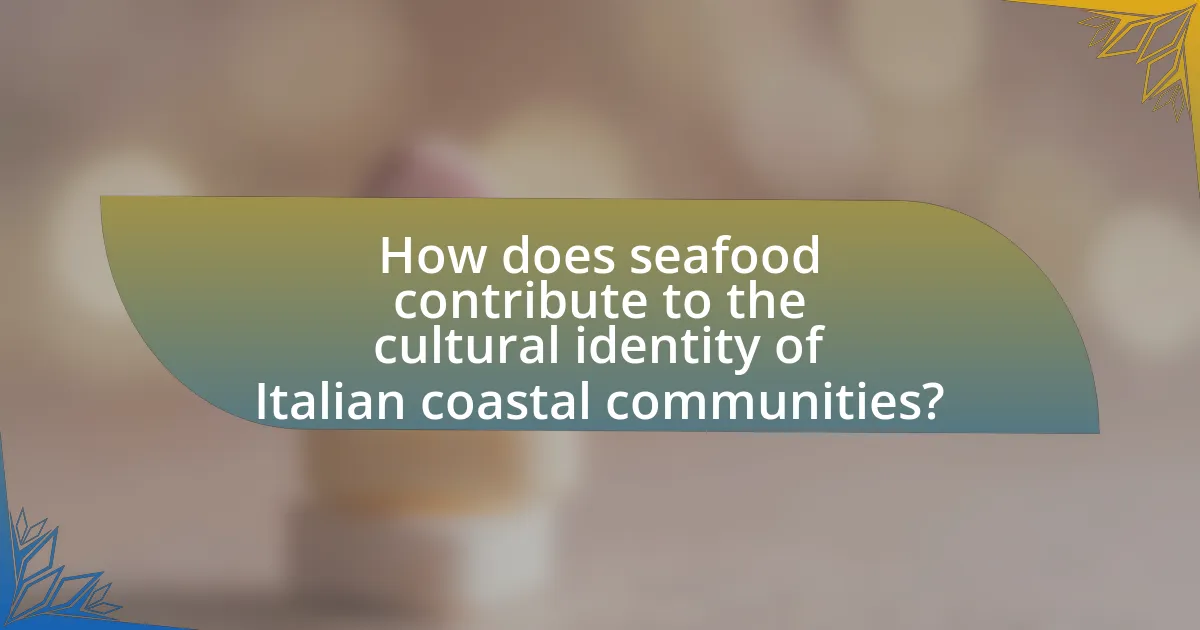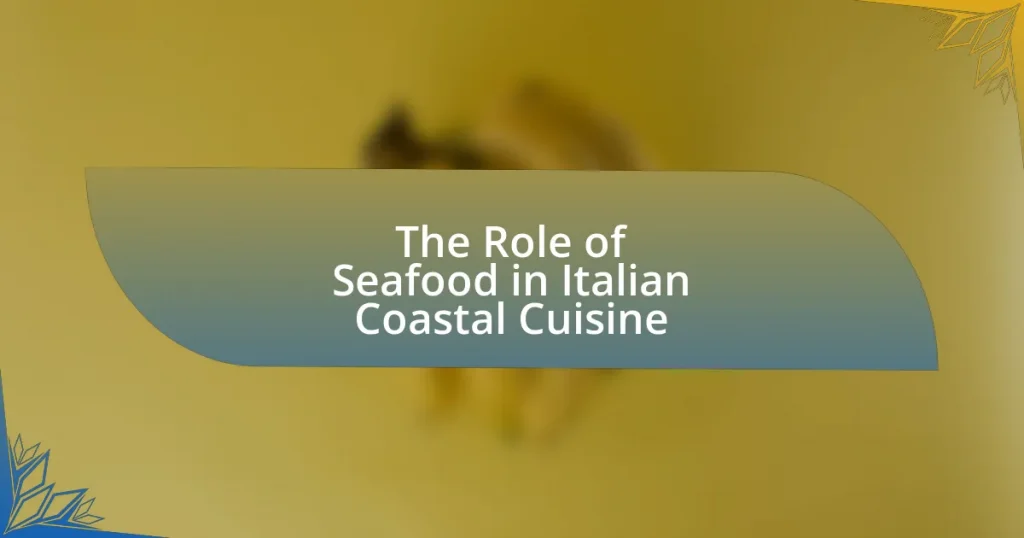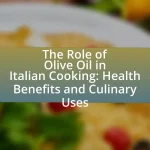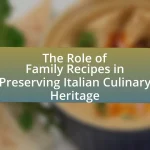Seafood is a fundamental component of Italian coastal cuisine, deeply rooted in the maritime heritage of regions such as Liguria, Campania, and Sicily. The article explores the significance of seafood in local culinary traditions, highlighting popular dishes, historical influences, and the impact of local fishing practices on ingredient availability. It also examines the role of seasonality in seafood selection, the preparation methods commonly used, and how seafood festivals celebrate this cultural connection. Additionally, the economic implications of seafood consumption for local communities and tips for preparing authentic Italian seafood dishes at home are discussed, emphasizing the importance of fresh, high-quality ingredients and traditional cooking techniques.

What is the Role of Seafood in Italian Coastal Cuisine?
Seafood plays a central role in Italian coastal cuisine, serving as a primary ingredient that reflects the region’s maritime heritage. Coastal areas of Italy, such as Liguria, Campania, and Sicily, utilize a variety of fresh seafood, including fish, shellfish, and crustaceans, which are often sourced directly from local waters. This reliance on seafood is not only a matter of availability but also a cultural tradition, as dishes like spaghetti alle vongole (spaghetti with clams) and fritto misto (mixed fried seafood) highlight the flavors and techniques unique to coastal cooking. The Mediterranean diet, which emphasizes fresh, seasonal ingredients, further underscores the importance of seafood in promoting health and sustainability within these culinary practices.
How has seafood influenced the culinary traditions of Italy’s coastal regions?
Seafood has significantly influenced the culinary traditions of Italy’s coastal regions by serving as a primary ingredient in local dishes and shaping regional cooking techniques. Coastal areas, such as Liguria, Campania, and Sicily, have developed unique recipes that highlight the freshness and variety of seafood available, including anchovies, sardines, and octopus. For instance, the famous Ligurian dish “trofie al pesto” often incorporates seafood, showcasing the blend of local flavors. Additionally, the Mediterranean diet, which emphasizes seafood consumption, has been linked to health benefits, further embedding seafood into the cultural fabric of these regions. Historical trade routes and fishing practices have also contributed to the prominence of seafood in Italian coastal cuisine, making it an integral part of their culinary identity.
What historical factors contributed to the prominence of seafood in these regions?
The prominence of seafood in Italian coastal cuisine is primarily attributed to the geographical location of Italy, which is surrounded by the Mediterranean Sea. This access to abundant marine resources has historically facilitated fishing as a vital economic activity. Additionally, ancient civilizations such as the Romans and Greeks heavily relied on seafood, integrating it into their diets and culinary traditions. The development of trade routes during the Middle Ages further enhanced the availability of seafood, allowing for diverse preparation methods and regional specialties to emerge. Historical records indicate that coastal communities have long depended on fishing for sustenance and commerce, solidifying seafood’s role in their cultural identity and cuisine.
How do local fishing practices shape seafood dishes in Italian coastal cuisine?
Local fishing practices significantly influence seafood dishes in Italian coastal cuisine by dictating the types of fish and shellfish available for culinary use. Each coastal region in Italy employs unique fishing methods, such as traditional small-scale fishing or aquaculture, which directly affects the freshness and variety of seafood. For example, the use of nets and traps in the Adriatic Sea yields specific species like sardines and anchovies, which are staples in regional recipes. Additionally, the seasonal catch informs local dishes, as chefs adapt their menus to highlight the freshest ingredients, ensuring that traditional recipes remain relevant and reflective of the local marine environment. This connection between fishing practices and culinary traditions is evident in dishes like spaghetti alle vongole, where the availability of clams from local waters shapes the preparation and flavor profile.
What types of seafood are commonly used in Italian coastal dishes?
Italian coastal dishes commonly feature seafood such as anchovies, clams, mussels, squid, octopus, and various types of fish like sardines and sea bass. These seafood varieties are integral to the cuisine, reflecting the Mediterranean diet and the availability of fresh catch along Italy’s extensive coastline. For instance, clams and mussels are often used in pasta dishes like spaghetti alle vongole, while squid is a key ingredient in dishes like calamari fritti. The use of these seafood types is supported by Italy’s rich maritime tradition, where fishing has been a vital part of local economies and culinary practices for centuries.
Which fish varieties are most popular in Italian coastal cuisine?
The most popular fish varieties in Italian coastal cuisine include anchovies, sardines, and sea bass. Anchovies are frequently used in dishes such as pasta and pizza, while sardines are often grilled or preserved. Sea bass, known for its delicate flavor, is commonly prepared whole or filleted and served with various sauces. These fish are integral to the Mediterranean diet, reflecting the region’s fishing traditions and culinary practices.
What shellfish are integral to traditional coastal recipes?
Mussels, clams, and shrimp are integral to traditional coastal recipes in Italian cuisine. These shellfish are commonly featured in dishes such as “spaghetti alle vongole” (spaghetti with clams) and “cozze alla marinara” (mussels in a marinara sauce). Historical records indicate that coastal communities in Italy have relied on these shellfish for centuries, utilizing them for their flavor and nutritional value, which enhances the overall culinary experience.
How is seafood prepared and served in Italian coastal cuisine?
Seafood in Italian coastal cuisine is typically prepared using methods such as grilling, frying, and baking, often accompanied by fresh herbs, olive oil, and citrus. Dishes like “spaghetti alle vongole” (spaghetti with clams) and “frittura di pesce” (fried mixed seafood) exemplify this approach, showcasing the natural flavors of the seafood. The use of local ingredients, such as tomatoes and garlic, enhances the dishes, while traditional techniques like “alla griglia” (grilled) and “al forno” (baked) highlight the freshness of the catch. This culinary style reflects the Mediterranean diet, which emphasizes seafood as a primary protein source, contributing to its popularity and cultural significance in coastal regions of Italy.
What cooking techniques are commonly used for seafood dishes?
Common cooking techniques for seafood dishes include grilling, steaming, poaching, frying, and baking. Grilling enhances the natural flavors of seafood, often used for fish and shellfish, while steaming preserves moisture and nutrients, making it ideal for delicate varieties. Poaching involves gently cooking seafood in liquid, which results in tender textures, commonly applied to fish like salmon. Frying, whether deep or pan-frying, creates a crispy exterior, popular for dishes like calamari. Baking allows for even cooking and is frequently used for whole fish or seafood casseroles. These techniques are foundational in Italian coastal cuisine, where freshness and flavor are paramount.
How do regional variations affect seafood preparation methods?
Regional variations significantly influence seafood preparation methods by dictating the types of seafood available and the culinary traditions of each area. For instance, coastal regions in Italy, such as Liguria, emphasize the use of fresh anchovies and basil in dishes like “trofie al pesto,” while Sicilian cuisine often features swordfish and capers in preparations like “swordfish involtini.” These regional preferences are shaped by local fishing practices, climate, and historical trade routes, which determine the availability of specific seafood. Additionally, cooking techniques vary; for example, grilling is prevalent in southern Italy, while northern regions may favor stewing or frying. This diversity in ingredients and methods reflects the cultural heritage and environmental factors unique to each region, showcasing how geography directly impacts culinary practices.

What are the key characteristics of Italian coastal seafood dishes?
Italian coastal seafood dishes are characterized by their freshness, simplicity, and emphasis on local ingredients. These dishes often feature freshly caught fish and shellfish, reflecting the region’s proximity to the sea. The preparation methods are typically straightforward, allowing the natural flavors of the seafood to shine through, often enhanced by olive oil, garlic, and fresh herbs. Additionally, many Italian coastal seafood dishes incorporate seasonal vegetables and grains, such as pasta or rice, creating a balanced meal. The use of regional specialties, like anchovies from the Amalfi Coast or sardines from Sicily, further highlights the diversity and richness of Italy’s coastal culinary traditions.
How do flavors and ingredients enhance seafood dishes?
Flavors and ingredients enhance seafood dishes by complementing the natural taste of the seafood and elevating the overall dining experience. Fresh herbs like basil and parsley, citrus elements such as lemon and lime, and aromatic spices like garlic and chili create a balance that highlights the seafood’s delicate flavors. For instance, the use of olive oil not only adds richness but also helps in the absorption of fat-soluble vitamins present in seafood. Additionally, traditional Italian coastal cuisine often incorporates local ingredients, which ensures freshness and authenticity, further enhancing the dish’s appeal. Studies show that the combination of these flavors can significantly improve the sensory attributes of seafood, making it more enjoyable for consumers.
What herbs and spices are typically paired with seafood in Italian cuisine?
Herbs and spices typically paired with seafood in Italian cuisine include parsley, basil, oregano, garlic, and red pepper flakes. Parsley is often used as a garnish and adds freshness, while basil complements dishes like seafood pasta. Oregano is frequently found in marinades and sauces, enhancing the flavor of grilled fish. Garlic is a staple in many seafood preparations, providing depth and aroma. Red pepper flakes add a touch of heat, balancing the natural flavors of the seafood. These ingredients are integral to Italian coastal cuisine, reflecting the region’s emphasis on fresh, vibrant flavors.
How do sauces complement seafood dishes in coastal Italy?
Sauces enhance seafood dishes in coastal Italy by adding depth of flavor and balancing the natural taste of the seafood. For instance, a classic sauce like salsa verde, made from parsley, capers, and olive oil, complements grilled fish by providing a fresh, tangy contrast that elevates the dish. Additionally, tomato-based sauces, such as those used in spaghetti alle vongole, enrich the dish with acidity and sweetness, harmonizing with the brininess of clams. The use of local ingredients, such as fresh herbs and citrus, further emphasizes the regional flavors, making sauces integral to the culinary experience of coastal Italian seafood.
What role does seasonality play in seafood availability and dish creation?
Seasonality significantly influences seafood availability and dish creation in Italian coastal cuisine. Different species of seafood are harvested at specific times of the year, affecting what is fresh and accessible for culinary use. For example, certain fish like anchovies are abundant in spring, while shellfish such as clams peak in summer. This seasonal availability dictates the ingredients chefs use, leading to the creation of dishes that highlight the freshest catches. Additionally, traditional Italian recipes often reflect these seasonal patterns, ensuring that the cuisine remains aligned with the natural rhythms of the sea. This practice not only enhances flavor but also supports sustainable fishing practices by encouraging the consumption of seafood during its peak season.
How do seasonal changes influence the types of seafood used in recipes?
Seasonal changes significantly influence the types of seafood used in recipes, as different species are available and at their peak during specific times of the year. For instance, spring often brings an abundance of anchovies and sardines, while summer is ideal for enjoying fresh tuna and swordfish. In autumn, shellfish like clams and mussels become more prevalent, and winter is the season for hearty fish such as cod and haddock. This seasonal availability is driven by factors like spawning cycles and water temperatures, which affect fish populations and their migration patterns. Consequently, Italian coastal cuisine adapts to these seasonal variations, emphasizing the freshest seafood options to enhance flavor and sustainability in recipes.
What are the best practices for sourcing fresh seafood in coastal regions?
The best practices for sourcing fresh seafood in coastal regions include establishing relationships with local fishermen, prioritizing seasonal catches, and ensuring sustainability through responsible fishing methods. Local fishermen often provide the freshest seafood, as they typically catch fish daily, ensuring minimal time from ocean to table. Prioritizing seasonal catches aligns with the natural breeding cycles of fish, which supports healthier ecosystems and enhances flavor. Additionally, sourcing seafood from fisheries certified by organizations like the Marine Stewardship Council guarantees adherence to sustainable practices, helping to protect marine biodiversity. These practices not only ensure high-quality seafood but also support local economies and promote environmental stewardship.

How does seafood contribute to the cultural identity of Italian coastal communities?
Seafood is integral to the cultural identity of Italian coastal communities, serving as a primary source of sustenance and a symbol of local traditions. The historical reliance on fishing has shaped culinary practices, with dishes like spaghetti alle vongole and fritto misto reflecting regional flavors and techniques passed down through generations. Additionally, seafood festivals, such as the Feast of the Sea in various coastal towns, celebrate this connection, reinforcing community bonds and cultural heritage. The Mediterranean diet, which emphasizes seafood, is recognized by UNESCO as an Intangible Cultural Heritage, highlighting its significance in promoting social cohesion and cultural identity among these communities.
What festivals and events celebrate seafood in Italian coastal regions?
Italian coastal regions celebrate seafood through various festivals and events, including the Feast of San Giovanni in Naples, the Sagra del Pesce in Camogli, and the Festa del Mare in Sicily. The Feast of San Giovanni features traditional seafood dishes and is celebrated with a procession and fireworks, highlighting the cultural significance of seafood in local cuisine. The Sagra del Pesce, held annually in Camogli, showcases fresh fish and local culinary traditions, attracting thousands of visitors who enjoy seafood prepared in traditional ways. The Festa del Mare in Sicily celebrates the sea’s bounty with food stalls, cooking demonstrations, and cultural performances, emphasizing the importance of seafood in Sicilian heritage. These events not only promote seafood but also reinforce the cultural identity of the coastal communities.
How do these events reflect the community’s relationship with the sea?
The events surrounding seafood in Italian coastal cuisine reflect the community’s deep reliance on the sea for sustenance and cultural identity. This relationship is evident in traditional fishing practices, seasonal seafood festivals, and culinary techniques that emphasize local marine resources. For instance, the annual Feast of San Giovanni in Naples celebrates the local fishing heritage, showcasing dishes made from freshly caught fish, which reinforces the community’s connection to the sea as a source of livelihood and tradition. Additionally, the prevalence of seafood in regional dishes highlights the importance of the sea in shaping local gastronomy and social customs, illustrating how the community’s identity is intertwined with maritime resources.
What traditional dishes are featured during seafood festivals?
Traditional dishes featured during seafood festivals include spaghetti alle vongole, which is a pasta dish made with clams, and fritto misto di mare, a mixed fried seafood platter. These dishes highlight the importance of fresh seafood in Italian coastal cuisine, where local ingredients are celebrated. For instance, spaghetti alle vongole is often prepared with clams sourced from nearby waters, showcasing regional flavors and culinary techniques. Fritto misto di mare typically includes a variety of seafood such as shrimp, squid, and small fish, reflecting the diversity of the catch available in coastal areas.
How does seafood consumption impact local economies?
Seafood consumption significantly boosts local economies by creating jobs, supporting local fisheries, and enhancing tourism. In coastal regions, seafood industries provide employment opportunities in fishing, processing, and distribution, contributing to economic stability. For instance, the National Oceanic and Atmospheric Administration reported that commercial fishing and seafood processing generated over $200 billion in sales in the United States alone, highlighting the economic importance of this sector. Additionally, seafood restaurants attract tourists, further stimulating local businesses and services. In Italy, regions like Sicily and Liguria rely heavily on seafood for both cultural identity and economic growth, demonstrating the integral role of seafood in sustaining local economies.
What role does seafood play in tourism for coastal Italian towns?
Seafood is a central attraction for tourism in coastal Italian towns, significantly enhancing their appeal to visitors. The rich culinary heritage of these regions, characterized by fresh and diverse seafood dishes, draws tourists seeking authentic gastronomic experiences. For instance, towns like Cinque Terre and Amalfi Coast are renowned for their seafood specialties, such as anchovies and calamari, which are integral to local festivals and dining options. This culinary focus not only boosts local economies through restaurant patronage and food-related tourism but also fosters cultural exchange as visitors engage with traditional fishing practices and local markets.
How do local fisheries support the economy and culture of coastal communities?
Local fisheries significantly support the economy and culture of coastal communities by providing employment, sustaining local businesses, and preserving cultural traditions. Employment in fisheries creates jobs not only in fishing but also in processing, distribution, and retail, contributing to the economic stability of these communities. For instance, in Italy, fisheries are integral to the livelihoods of thousands, with the fishing industry contributing approximately 0.1% to the national GDP and supporting local economies through seafood sales and tourism. Additionally, local fisheries play a crucial role in maintaining cultural heritage, as traditional fishing practices and seafood recipes are passed down through generations, fostering a sense of identity and community pride. This cultural connection is evident in Italian coastal cuisine, where local seafood is celebrated in regional dishes, reinforcing the bond between the community and its maritime resources.
What are some tips for preparing authentic Italian coastal seafood dishes at home?
To prepare authentic Italian coastal seafood dishes at home, focus on using fresh, high-quality seafood, as freshness is crucial in Italian cuisine. Select local fish and shellfish that are in season, such as branzino, calamari, or clams, to ensure optimal flavor. Utilize simple cooking techniques like grilling, sautéing, or steaming to highlight the seafood’s natural taste, often complemented by olive oil, garlic, and fresh herbs like parsley or basil. Incorporate traditional Italian ingredients such as tomatoes, capers, and lemon to enhance the dish while maintaining authenticity. For example, a classic spaghetti alle vongole features clams, garlic, and parsley, showcasing the essence of coastal Italian cooking.
What essential ingredients should be stocked for Italian seafood recipes?
Essential ingredients for Italian seafood recipes include fresh seafood such as fish, shrimp, mussels, and calamari, along with staples like olive oil, garlic, tomatoes, white wine, and fresh herbs such as parsley and basil. Fresh seafood is crucial as it forms the foundation of the dish, while olive oil and garlic provide essential flavor profiles typical in Italian cuisine. Tomatoes and white wine are often used in sauces, enhancing the overall taste, and fresh herbs add aromatic qualities that elevate the dish. These ingredients are commonly found in traditional Italian seafood recipes, reflecting the coastal regions’ reliance on local produce and seafood.
How can home cooks replicate traditional cooking techniques for seafood?
Home cooks can replicate traditional cooking techniques for seafood by utilizing methods such as grilling, poaching, and sautéing, which are commonly used in Italian coastal cuisine. For instance, grilling seafood over an open flame enhances its natural flavors, a technique often seen in Italian seaside towns where fresh catch is abundant. Poaching seafood in a broth made from white wine, herbs, and aromatics preserves moisture and infuses flavor, reflecting traditional Italian practices. Sautéing seafood quickly in olive oil with garlic and fresh herbs allows for a vibrant dish that showcases the ingredients, aligning with the Italian emphasis on simplicity and quality. These techniques are validated by culinary traditions in regions like Liguria and Sicily, where seafood is a staple and these methods are integral to the cuisine.















